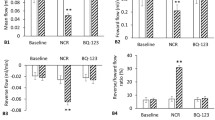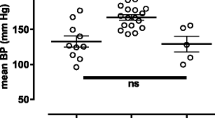Abstract
During a pressure rise, the aortic enlargement is followed by an arterial compliance reduction. For elevated pressure levels, vascular smooth muscle (VSM) activation produces an arterial compliance improvement. To better understand this observation, we studied the aortic elasticity function during high pressure states with and without VSM activation. Simultaneous aortic pressure and diameter were measured in conscious dogs. Animals were separated into groups corresponding to different types of VSM activation: PHE group (phenylephrine 5 μg/kg/min, n = 7) and RAS group (renin-angiotensin system stimulation via renal vasoconstriction, n = 7). An arterial biphasic elasticity function was adjusted with a mechanical occlusion intervention. Pressure-diameter loops were compared isobarically between VSM activation and mechanical occlusion. In the PHE group, activation increased aortic distension from 2.6 ± 0.7% to 5.4 ± 1.0% (p < 0.01) and compliance from 0.30 ± 0.07 mm2/mmHg to 0.58 ± 0.11 mm2/mmHg (p < 0.01). Similarly, in the RAS group, aortic distension increased from 4.8 ± 1.5% to 7.4 ± 2.4% (p < 0.05) and compliance from 0.48 ± 0.18 mm2/mmHg to 0.70 ± 0.28 mm2/mmHg (p < 0.05). When VSM activation produces an arterial pressure rise concomitant with an aortic wall contraction, arterial compliance and distension increase with respect to an isobaric mechanical occlusion. The assessment of the aortic geometry helps to explaining the cardiovascular system behavior during acute and chronic high-pressure states.




Similar content being viewed by others
References
Armentano, R. L., J. Levenson, J. G. Barra, E. I. Fischer, G. J. Breitbart, R. H. Pichel, et al. Assessment of elastin and collagen contribution to aortic elasticity in conscious dogs. Am. J. Physiol. 260(6 Pt 2):H1870–H1877, 1991.
Armentano, R. L., J. G. Barra, J. Levenson, A. Simon, and R. H. Pichel. Arterial wall mechanics in conscious dogs. Assessment of viscous, inertial, and elastic moduli to characterize aortic wall behavior. Circ. Res. 76(3):468–478, 1995.
Armentano, R., J. L. Megnien, A. Simon, F. Bellenfant, J. Barra, and J. Levenson. Effects of hypertension on viscoelasticity of carotid and femoral arteries in humans. Hypertension 26(1):48–54, 1995.
Armentano, R. L., J. G. Barra, D. B. Santana, F. M. Pessana, S. Graf, D. Craiem, et al. Smart damping modulation of carotid wall energetics in human hypertension: effects of angiotensin-converting enzyme inhibition. Hypertension 47(3):384–390, 2006. doi:01.HYP.0000205915.15940.15[pii]10.1161/01.HYP.0000205915.15940.15.
Armentano, R. L., J. G. Barra, F. M. Pessana, D. O. Craiem, S. Graf, D. B. Santana, et al. Smart smooth muscle spring-dampers. Smooth muscle smart filtering helps to more efficiently protect the arterial wall. IEEE Eng. Med. Biol. Mag. 26(1):62–70, 2007.
Atlas, G., and J. K. Li. Brachial artery differential characteristic impedance: Contributions from changes in young’s modulus and diameter. Cardiovasc. Eng. 9(1):11–17, 2009. doi:10.1007/s10558-009-9071-6.
Bank, A. J., and D. R. Kaiser. Smooth muscle relaxation: effects on arterial compliance, distensibility, elastic modulus, and pulse wave velocity. Hypertension 32(2):356–359, 1998.
Bank, A. J., R. F. Wilson, S. H. Kubo, J. E. Holte, T. J. Dresing, and H. Wang. Direct effects of smooth muscle relaxation and contraction on in vivo human brachial artery elastic properties. Circ. Res. 77(5):1008–1016, 1995.
Barra, J. G., R. L. Armentano, J. Levenson, E. I. Fischer, R. H. Pichel, and A. Simon. Assessment of smooth muscle contribution to descending thoracic aortic elastic mechanics in conscious dogs. Circ. Res. 73(6):1040–1050, 1993.
Barra, J. G., J. Levenson, R. L. Armentano, E. I. Cabrera Fischer, R. H. Pichel, and A. Simon. In vivo angiotensin II receptor blockade and converting enzyme inhibition on canine aortic viscoelasticity. Am. J. Physiol. 272(2 Pt 2):H859–H868, 1997.
Bauer, R. D. Rheological approaches of arteries. Biorheology Suppl. 1:159–167, 1984.
Bergel, D. H. The dynamic elastic properties of the arterial wall. J. Physiol. 156(3):458–469, 1961.
Boutouyrie, P., S. Boumaza, P. Challande, P. Lacolley, and S. Laurent. Smooth muscle tone and arterial wall viscosity: an in vivo/in vitro study. Hypertension 32(2):360–364, 1998.
Cholley, B. P., R. M. Lang, C. E. Korcarz, and S. G. Shroff. Smooth muscle relaxation and local hydraulic impedance properties of the aorta. J. Appl. Physiol. 90(6):2427–2438, 2001.
Craiem, D., and R. L. Armentano. A fractional derivative model to describe arterial viscoelasticity. Biorheology 44(4):251–263, 2007.
Dobrin, P. B., and A. A. Rovick. Influence of vascular smooth muscle on contractile mechanics and elasticity of arteries. Am. J. Physiol. 217(6):1644–1651, 1969.
Fischer, E. I., J. Levenson, J. G. Barra, R. L. Armentano, R. H. Pichel, and A. Simon. Preventive effect of chronic converting enzyme inhibition on aortic stiffening induced by renovascular hypertension in conscious dogs. Cardiovasc. Res. 27(6):1039–1044, 1993.
Gow, B. S., and M. G. Taylor. Measurement of viscoelastic properties of arteries in the living dog. Circ. Res. 23(1):111–122, 1968.
Hermeling, E., A. P. Hoeks, M. H. Winkens, J. L. Waltenberger, R. S. Reneman, A. A. Kroon, et al. Noninvasive assessment of arterial stiffness should discriminate between systolic and diastolic pressure ranges. Hypertension 55(1):124–130, 2010.
Li, J. K. The Arterial Circulation: Physical Principles and Clinical Applications. Totowa: Humana Press, 2000.
Li, J. K., Y. Zhu, and P. S. Geipel. Pulse pressure, arterial compliance and wave reflection under differential vasoactive and mechanical loading. Cardiovasc. Eng. 10(4):170–175, 2010. doi:10.1007/s10558-010-9107-y.
Meinders, J. M., and A. P. Hoeks. Simultaneous assessment of diameter and pressure waveforms in the carotid artery. Ultrasound Med. Biol. 30(2):147–154, 2004. doi:10.1016/j.ultrasmedbio.2003.10.014.S0301562903011487[pii].
Nichols, W. W., and M. F. O’Rourke. McDonald’s Blood Flow in Arteries. Theoretical, Experimental and Clinical Principles. London, UK: Eduard Arnold, 1998.
Simon, A. C., M. E. Safar, J. A. Levenson, G. M. London, B. I. Levy, and N. P. Chau. An evaluation of large arteries compliance in man. Am. J. Physiol. 237(5):H550–H554, 1979.
Stefanadis, C., J. Dernellis, C. Vlachopoulos, C. Tsioufis, E. Tsiamis, K. Toutouzas, et al. Aortic function in arterial hypertension determined by pressure-diameter relation: effects of diltiazem. Circulation 96(6):1853–1858, 1997.
Stergiopulos, N., J. J. Meister, and N. Westerhof. Evaluation of methods for estimation of total arterial compliance. Am. J. Physiol. 268(4 Pt 2):H1540–H1548, 1995.
VanBavel, E., P. Siersma, and J. A. Spaan. Elasticity of passive blood vessels: a new concept. Am. J. Physiol. Heart Circ. Physiol. 285(5):H1986–H2000, 2003. doi:10.1152/ajpheart.00248.2003.00248.2003[pii].
Vito, R. P., and S. A. Dixon. Blood vessel constitutive models-1995–2002. Annu. Rev. Biomed. Eng. 5:413–439, 2003. doi:10.1146/annurev.bioeng.5.011303.120719.011303.120719[pii].
Wells, S. M., B. L. Langille, J. M. Lee, and S. L. Adamson. Determinants of mechanical properties in the developing ovine thoracic aorta. Am. J. Physiol. 277(4 Pt 2):H1385–H1391, 1999.
Westerhof, N., and A. Noordergraaf. Arterial viscoelasticity: a generalized model. Effect on input impedance and wave travel in the systematic tree. J. Biomech. 3(3):357–379, 1970.
Zhang, W., Y. Liu, and G. S. Kassab. Viscoelasticity reduces the dynamic stresses and strains in the vessel wall: implications for vessel fatigue. Am. J. Physiol. Heart Circ. Physiol. 293(4):H2355–H2360, 2007. doi:00423.2007[pii]10.1152/ajpheart.00423.2007.
Acknowledgments
This work was in part subsidized by the project PIP number 112-200901-00734 (CONICET) and project PICTO 31355 (ANPCyT).
Conflicts of interest
None.
Author information
Authors and Affiliations
Corresponding author
Additional information
Associate Editor Ajit P. Yoganathan oversaw the review of this article.
Rights and permissions
About this article
Cite this article
Craiem, D., Graf, S., Armentano, R.L. et al. Vascular Smooth Muscle Activation Improves Aortic Compliance with Respect to Mechanical Loading. Cardiovasc Eng Tech 3, 80–87 (2012). https://doi.org/10.1007/s13239-011-0069-z
Received:
Accepted:
Published:
Issue Date:
DOI: https://doi.org/10.1007/s13239-011-0069-z




